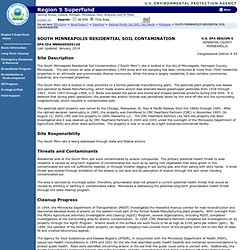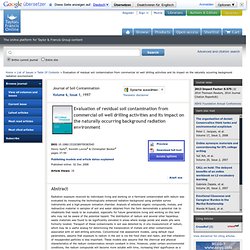

2013-01-15-waterfluoridationfacts.jpg (800×1218) STEVEN SEAGAL TOLD US THE TRUTH AND WE DIDN'T LISTEN! Official Chemtrail Forecast and Report Center. Geo. H.A.A.R.P. Kucinich Calls Out Monsanto: Americans Demand GMO Labeling. Monsanto. GMO's. Petitions - Repeal the Monsanto Protection Act. E64737. Brief Introduction to Water and Soil Pollution. Guidetosoil. Detailed analysis of industrial and commercial activities causing soil contamination by country. Vol2no5. MNN000509136, NPL Fact Sheet. Congressional District # 05 EPA ID# MNN000509136 Last Updated: January, 2014 Site Description The South Minneapolis Residential Soil Contamination ("South Minn") site is located in the city of Minneapolis, Hennepin County, Minnesota.

The site covers an area of approximately 1,480 acres and soil sampling has been conducted at more than 3500 residential properties in an ethnically and economically diverse community. While the area is largely residential, it also contains commercial, industrial, and municipal properties. The South Minn site is located in close proximity to a former pesticide manufacturing plant. The pesticide plant property was owned by the Chicago, Milwaukee, St.
Site Responsibility The South Minn site is being addressed through state and federal actions. Threats and Contaminants Residential soils at the South Minn site were contaminated by arsenic compounds. Cleanup Progress In 2001 and 2003, MDA and MDH performed limited soil investigations in residential yards. Success Story. Fake sweetener Splenda fills our oceans, scientists find. (NaturalNews) A new study by scientists from the University of North Carolina at Wilmington found that the bulk of the popular sweetener Splenda, which is used all over the world, is winding up in the Gulf Stream, the "conveyor belt of water transport" that circulates in the Atlantic Ocean from the coast of North American to Europe, Africa and beyond.

The study, conducted by the scientists at the university's Marine Atmospheric Chemistry Research Laboratory and the journal Marine Chemistry, said that only about 10 percent of the main component in Splenda, which is sucralose, is absorbed by the body, meaning 90 percent of it leaves the body and winds up in sewage systems. "Sucralose, discovered in 1976 and made popular by Splenda in 1999, is used in 80 countries to sweeten foods and drinks without the calories and carbohydrates of sugar," said the university in a press release. Long-term effects? We don't know yet, and that's the problem Sucralose causes weight gain as well. T & F Online. Radiation exposure received by individuals living and working on a farmland contaminated with radium was evaluated by measuring the technologically enhanced radiation background using portable survey instruments and a high‐pressure ionization chamber.

Analysis of selected organic compounds, metals, and radioactive material in samples of soil and water obtained from the farm demonstrate a potential risk to inhabitants that needs to be evaluated, especially for future generations living and working on this land who may not be aware of the potential hazard. The distribution of radium and several other hazardous waste materials was found to be significantly elevated in areas where sludge ponds and waste pits were formerly located.
Transport of these contaminants in soil was detected by in situ measurement of radium, which may be a useful analog for determining the translocation of metals and other contaminants associated with oil well‐drilling activities. Key words Related articles. EPA to clean up lead in yard soil in N.J. The Environmental Protection Agency will begin digging up dangerous lead contamination this month around a dozen homes in New Jersey, part of one of the largest state efforts yet to re-examine health risks posed by soil near hundreds of old factory locations identified by a USA TODAY investigation.

Regulators in at least 13 other states have been conducting investigations as a result of the newspaper's "Ghost Factories" series, which revealed the EPA and state agencies had done little over 10 years to examine the toxic fallout left behind by many old lead factories that operated mostly in the 1930s-1960s . In Edison, N.J., the EPA will spend up to $1.26 million to replace the soil in local yards. State regulators also have asked the EPA to clean up contamination at a Newark condo complex built atop another factory site. VIDEO: EPA, state respond to lead smelter sites in New Jersey The lack of action at sites with adjacent homes concerns some community advocates. L.H.